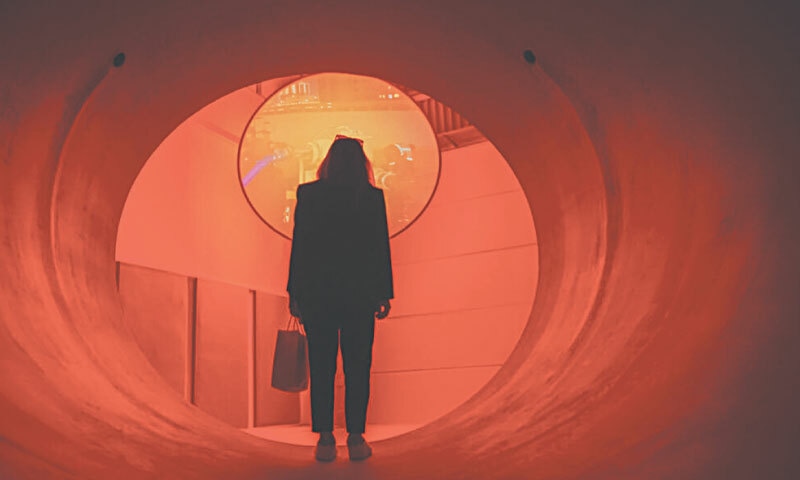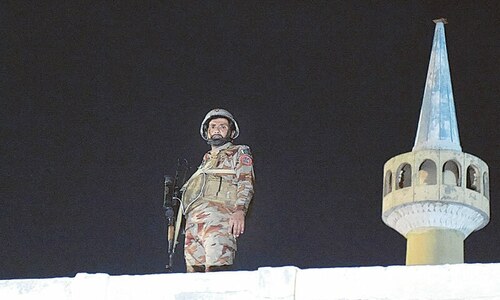Coming to Sharjah always feels like visiting an old friend, or maybe a distant family member — a familiarity with the landscape and urban ecology vis-à-vis Karachi: dense concrete towers, the concentration of South Asian populations, the cuisine, the architecture. It is within this context that I engage with the Sharjah Biennale 16.
This year, under the theme “to carry”, the Biennale asked what “we bring with us when we travel, flee, survive or stay.” The intentional non-capitalisation of these words spoke to me about its quiet but revolutionary possibility.
Moving through borders and oceans to arrive at this year’s edition, I was also overcome by how, in this art world, we are carried through relationships, friendships and communities. In these times — with the ongoing genocide in Palestine and so much geo-political fracturing — the Biennale was a welcome and emotive carrier of many stories and dreams of those whose voices we may not hear immediately, but who demand that we listen with urgency, care and generosity.
An exhibition of this scope and scale — with five curators, over 190 artists, rich and complex projects showcasing the incredible legacy and impact of South Asian artists such as Viswanadhan, Chandralekha and SM Sultan, and exhibitions within exhibitions — it can indeed be difficult to do justice to this biennale through the written word. For the purposes of this review, I thread together ideas of water and sound, especially through the lens of lament and ancestral memory.
In the urban fabric of Sharjah, which is so deeply intertwined with South Asian histories, Sharjah Biennale 16 emerges as a site of storytelling and resistance by invoking ancestral voices and contemporary urgencies
Bait Habib Al Yousef was a particularly evocative and tightly curated section at the Biennale, with Lahore-based artist Risham Syed’s new work, Un, Pani, Sutt [Grain, Water, Truth], welcoming us into the courtyard through grain that was slowly going to mature over time. When I visited in February, the grain was still a lush young green, but by March it had matured into golden long grains. At the opening, Risham mentioned the idea of sharing grain and langar as a form of building community.

Her agricultural and sonic installation connected two performances, drawing from verses of the Mul Mantar and poetry by her father, Najm Hosain Syed. The entrance corridor embalmed us with the tender singing voice of her late mother, Samina Hasan Syed, while the second sonic work was performed by Risham’s daughter, Mohrelle Hassan, who is being trained in this classical tradition. In this way, Risham’s work drew ancestral connections of orality and memory as unbroken tethers, even within the fractured landscape of Punjab after Partition.
In the section upstairs, viewers could engage with dense paintings by Mozambican artist Cassie Namoda, depicting the labour of women and communities on the coast. Installed on the rooftop, Why such a journey devoid of return, was a dhow sail gesturally painted and set against the backdrop of the Sharjah Corniche, from where one can see the shimmers of connected oceanic geographies towards the Makran and Sindh coast, and the Swahili coast — vessels that were and are still carried together in memory.
Movement across sea geographies also featured evocatively in the work of Brisbane-based artist Sancintya Mohini Simpson, whose triptych of paintings depicted scenes of indentured movement and flow, and whose poetry on the wall reminded us of the jahajin [ship-sisters] — a reminder of matriarchal narratives usually forgotten when history is transcribed. At the opening week, Sancintya’s powerful and enduring performance, Kala Pani [Black Water], also drew on ancestral histories, embodying sound and water as sources of trauma but also knowledge and healing.

Lament and storytelling were also replete in the work of Fazal Rizvi, an artist from Karachi, whose new commission, Kissing of the Threshold, drew on Shia Muslim rituals. Consisting of a large-scale installation with buckets of water, a mound representing a grave, and an eight-channel audio work, I felt an embodied familiarity with this work and let myself be carried through the voice of the artist as he recited soz khwani. Sitting alone within his installation, I thought about death being a part of many artistic practices at the Biennale. Here, I wondered, how do we carry ourselves in the life that is to come after this world?
Within the sprawl of the Emirate of Sharjah lies the intriguing Madam Buried Village, an organised village built in 1971 to settle the local Bedouin community. However, it was soon abandoned due to the difficult living conditions — for me a sign of modernity and nation-building’s disconnect with indigenous ways of knowing and being.
This abandoned village now seems to be full of ghosts of possibilities that were never realised, with each house buried through the shifting sands of time. Here, the US-based Diné indigenous artist Raven Chacon’s evocative songs echoed from these homes in constellation, imagining what lives would have been here, in another future. Moving through this site on a very hot day, as these sounds emerged from these homes, I also saw inscriptions by visitors, a different archive built over time, adding to the work itself.

Traversing through the landscape of Sharjah, we arrived at the other coast to the town of Kalba (this being the only emirate on both the Persian Gulf and Gulf of Oman). Here, in a former ice factory, filled with multiple large-scale installations and complex works, I was particularly drawn to Adelita Husni Bey’s installation Like a Flood. This was a two-channel video work and an 18-channel audio installation that investigated and linked, through careful archival research, the roots of Libya’s current water crisis to the history of Italian colonial extraction.
The viewer was literally forced to move into a large water pipe and sit within it in order to properly view the work. All I could remember when seeing this installation was the acute water crisis in Karachi, with its network of tanker mafias and broken infrastructure. As we face increased scarcity of resources under capitalist conditions, how do we carry and care for our own anxieties whilst building relationships of sharing and abundance?
I stay with this feeling of anxiety, as I move through a world that seems to be on the precarious edge of collapse. During this, I turn, with gratitude, to these artists and voices at the Biennale. They seem like oracles and are a reminder of our intertwined destinies, which we must acknowledge if we are to carry each other across time and space into a better world.
Sharjah Biennale 16 is on display across the Emirate of Sharjah from February 6-June 15, 2025
Aziz Sohail is a curator and writer from Karachi, currently based in Melbourne, Australia. His work builds interdisciplinary connections between art, history, archives, literature, theory and biography, and supports new cultural and pedagogical infrastructures
Published in Dawn, EOS, April 6th, 2025
















































